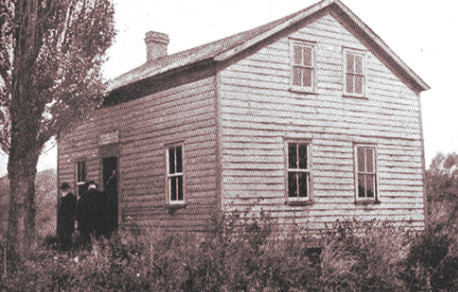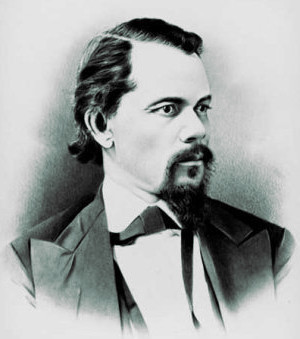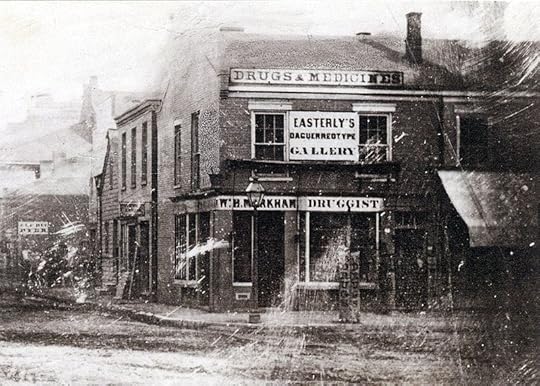Michael Gallagher's Blog - Posts Tagged "kate-fox"
Why the Victorians saw ghosts: an early April Fool?
 While I was researching my novel,
The Bridge of Dead Things
, I came to understand that the Victorian vogue for spiritualism did not happen in a vacuum. It grew out of a very specific culture, at a particular point in time, and it fulfilled a number of surprisingly different needs. This is the first in a series of posts that examines various influences on the development of spiritualism.
While I was researching my novel,
The Bridge of Dead Things
, I came to understand that the Victorian vogue for spiritualism did not happen in a vacuum. It grew out of a very specific culture, at a particular point in time, and it fulfilled a number of surprisingly different needs. This is the first in a series of posts that examines various influences on the development of spiritualism.The story of spiritualism starts with a house that had an uncanny reputation in Hydesville, New York, a hamlet which no longer exists but was then situated in Wayne County in New York State. John Fox, a farmer, took over the tenancy with his wife Margaret and two of his children, Margaret and Kate on December 11th, 1847. Three months of relative peace went by, then at the tail end of March, when his daughters were aged fourteen and eleven respectively, the knocking began. Noises were heard all through the house. John and his wife investigated, but could find no explanation for the sounds.
On Friday the 31st of March the family retired early for the night, with the girls sleeping in the same room as their parents, when the commotion began again. Kate, the youngest challenged the noise-maker, saying, "Mr. Splitfoot, do as I do," whilst clapping her hands. The sound instantly followed her with the same number of raps.
According to Mrs Fox’s own testimony, “…[Kate] said in her childish simplicity, "Oh, mother, I know what it is. To-morrow is April-fool day, and it's somebody trying to fool us." I then thought I could put a test that no one in the place could answer. I asked the noise to rap my different children's ages, successively. Instantly, each one of my children's ages was given correctly, pausing between them sufficiently long to individualize them until the seventh, at which a longer pause was made, and then three more emphatic raps were given, corresponding to the age of the little one that died, which was my youngest child. I then asked: "Is this a human being that answers my questions so correctly?" There was no rap. I asked: "Is it a spirit? If it is, make two raps." Two sounds were given as soon as the request was made. I then said "If it was an injured spirit, make two raps," which were instantly made, causing the house to tremble. I asked: "Were you injured in this house?" The answer was given as before. "Is the person living that injured you?" Answered by raps in the same manner. I ascertained by the same method that it was a man, aged thirty-one years, that he had been murdered in this house, and his remains were buried in the cellar; that his family consisted of a wife and five children, two sons and three daughters, all living at the time of his death, but that his wife had since died. I asked: "Will you continue to rap if I call my neighbours that they may hear it too?" The raps were loud in the affirmative.”
Mr Fox called in a neighbour, a no-nonsense woman named Mrs Redfield. After the spirit had answered her questions she called for her husband, who then called in all the other neighbours, one of whom, Mr Duesler, managed to ascertain that the man was murdered in the east bedroom about five years ago; that the murder was committed on a Tuesday night at twelve o'clock; that he was murdered by having his throat cut with a butcher knife; that he was murdered for money; that the body was taken down to the cellar; that it was not buried until the next night; that it was taken through the buttery, down the stairway, and that it was now buried ten feet below the surface of the ground.
By the next day (April 1st) the house was full to overflowing with people curious to experience the now celebrated phenomena for themselves. In the evening they dug up the cellar until they came to water, and then they gave up. The knocking continued intermittently over the next few days. Within a week Mrs Fox’s hair had turned white from the anxiety.
Fourteen-year-old Margaret was sent to stay with her older brother David in the nearby town of Rochester; Kate also went to Rochester to stay with her older sister Leah, a music teacher whose married name was Fish. Unfortunately the rapping knocks went too. Hundreds flocked to Mrs Fish’s house to witness and marvel.
The knocking became contagious. It was no longer confined to the Fox family. Similar sounds were heard in the homes of the Reverend A. H. Jervis, a Methodist minister from Rochester, and a Mrs Sarah A. Tamlin, a Mrs Benedict, and a certain Deacon Hale, who lived in surrounding towns. Now the knocks claimed that they came from the deceased friends of those who were gathered there. The amateur séance was born.
These early enthusiasts were often reformers who championed the abolition of slavery, equal rights for women, and the temperance movement. Their involvement with spiritualism reflects a link between spiritualists and radical reformers, especially those who advocated women's rights, that would last for more than half a century.
At this point séances were essentially domestic affairs held in private homes. Soon, however, they would become much, much more.

Next month: there’s no business like show business
Find out more at
michaelgallagherwrites.com
Images:
The Fox sisters; Kate and Margaret Fox with their married sister, Mrs Leah Fish
Photographer and date unknown
The Foxes’ House, Hydesville, New York
Photographer and date unknown
Published on June 30, 2013 06:30
•
Tags:
fox-sisters, kate-fox, margaret-fox, mediums, seances, spiritualism, spiritualists, victorian-mediums, victorian-seances
Why the Victorians saw ghosts: there’s no business like show business
 While I was researching my novel,
The Bridge of Dead Things
, I came to understand that the Victorian vogue for spiritualism did not happen in a vacuum. It grew out of a very specific culture, at a particular point in time, and it fulfilled a number of surprisingly different needs. This is the second in a series of posts that examines various influences on the development of spiritualism.
While I was researching my novel,
The Bridge of Dead Things
, I came to understand that the Victorian vogue for spiritualism did not happen in a vacuum. It grew out of a very specific culture, at a particular point in time, and it fulfilled a number of surprisingly different needs. This is the second in a series of posts that examines various influences on the development of spiritualism.Although spiritualism and séances were always to retain a strong domestic, amateur appeal, in that they remained essentially private affairs practised by middle-class enthusiasts dabbling in table-rapping and table-turning in their own homes, they were destined to became public, professional affairs as well.
The small band of pioneers from Rochester (dubbed by many as "the Rochester rappers") received spirit messages urging them to hold an open meeting where their powers could be investigated and tested. This was a risky move, for although the spirits obliged with their normal fare of raps and knocks, the men who were testing the mediums refused to believe that they were caused by any outside agency.
Horace Greeley, the founder and editor of the New York Tribune, published their report, but also appended a note suggesting that their tests were invalid because of the men’s obvious bias. Supporters rallied to the call, giving testimony about the Fox sisters’ abilities. Rather than stifling spiritualism, the report fed the public interest in the girls.
Under the watchful supervision of their mother, the three Fox sisters began giving public sittings at Barnum's Hotel in New York in the spring of 1850. There’s a contemporary description written by a Mrs Emma Hardinge, who was later to become a medium in her own right, which gives us some idea of the pressure the girls faced. She talks of "pausing on the first floor to hear poor patient Kate Fox, in the midst of a captious, grumbling crowd of investigators, repeating hour after hour the letters of the alphabet, while the no less poor, patient spirits rapped out names, ages and dates to suit all comers." Although most of the press reports denounced them as frauds, Horace Greeley published a supportive and sympathetic article in his paper. After a tour of the Western States, the Fox family paid a second visit to New York, which again attracted an intense public interest, both positive and negative.
For some years the two younger sisters, Kate and Margaret, made their living by giving séances. An extraordinary daguerreotype of Kate and Margaret exists in the Missouri History Museum, made by the daguerreotypist Thomas M. Easterly at his studio in St. Louis, Missouri when the sisters stopped off there during their national tour of 1852. Do take the opportunity to click on this link and have a look. A daguerreotype is a photographic likeness made directly onto a sheet of polished silver-plated copper; no intermediary negative is used and no prints can be made, and consequently each daguerreotype is a one-off original. I wanted to use this image to head up this post, but although the copyright on the original expired long ago, the copyright on the reproduction that you see did not.
One of the early communications that the Fox sisters received had claimed that "these manifestations would not be confined to them, but would go all over the world." Their public demonstrations were proving to be so popular that now others began to copy and improve upon their format. In an incredibly short space of time the movement swept across the Northern and Eastern States of the Union, with mediums (or "trance lecturers" as they were known) competing to produce increasingly startling phenomena. A repertoire that had started as a simple series of loud raps and knocks now included the appearance of "spirit-lights" and disembodied hands and faces, automatic writing whilst the medium was apparently in a trance, channelled spirits who spoke to or through the medium, objects that moved by themselves, and even levitation. Spiritualism had become show business.
Prominent practitioners at this point included a certain Mrs Hayden, the two Davenport brothers, and Daniel Dunglas Home (all four of whom I will discuss in greater detail in a later post), the beautiful young Cora L. V. Hatch, Achsa W. Sprague, an abolitionist and advocate of equal rights for women, and Paschal Beverly Randolph, an intriguing man of mixed race who was one of the earliest abolitionists.
Paschal Beverly Randolph was one of this new breed of mediums to rise to prominence in the early 1850s. He was eloquent and good-looking, with a commanding stage presence and a compelling personality to match. From a young age he’d been obliged to make his living as an irregular crewman aboard a number of commercial vessels. His travels had taken him to England and France, and as far east as Persia, and had introduced him to a wealth of new ideas, religions and esoteric beliefs. It was during this time that he developed an deep and abiding interest for gnosticism, freemasonry, sexual magic and the occult.
On his return to America he started writing books (he wrote over fifty of them during his lifetime), many of which were vehicles for his masonic beliefs. Two of these have been lovingly recreated as e-books and are available as free downloads from the wonderful Gutenberg Project (though I warn you now, they are both written in the heavily veiled allegorical style that is typical of most masonic texts). As well as writing, Randolph set up his own publishing house and trained as a doctor. He also established the first Rosicrucian organisation in America, the Fraternitas Rosae Crucis (the Fraternity of the Rosy Cross). All through this period he worked as a trance lecturer, using his stage appearances to argue the case for the abolition of slavery.
As admirable as as all this may be (though it does go some way to demonstrate the strong bond between spiritualism and radical reform), the real reason for his inclusion here is that he provides an interesting link to next month’s post. It is claimed that in 1851, at the age of 25, Paschal Beverly Randolph made the acquaintance of Abraham Lincoln and struck up a friendship that lasted until Lincoln’s untimely death. Despite the fact that Lincoln’s second son, Eddie, had died the previous year from tuberculosis, it’s far more likely that the medium offered the great man his views on abolition, and not some form of spiritualist communion with his dead child. But, as we will see next time, Randolph was not the only medium to make Lincoln’s acquaintance.

Next month: a séance in the White House
Find out more at
michaelgallagherwrites.com
Images:
Paschal Beverly Randolph (1825-1875)
Thomas M. Easterly’s Daguerreotype Gallery, St. Louis
Photographer unidentified, but presumably Thomas M. Easterly himself (1809-1882), 1851
Published on August 01, 2013 04:04
•
Tags:
fox-sisters, horace-greeley, kate-fox, margaret-fox, mediums, new-york-times, paschal-beverly-randolph, rochester, seances, spiritualism, spiritualists, victorian-mediums, victorian-seances



